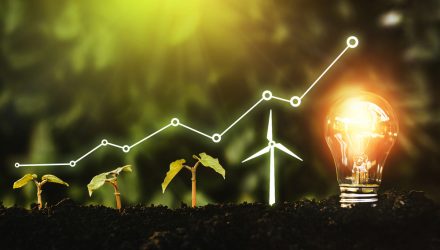“Greenflation” — the notion that some asset prices are being inflated by the world’s transition to renewable energy — is a real concept, but it doesn’t have to threaten portfolios.
Actually, astute advisors and investors will find avenues for making greenflation work for them. Some exchange traded funds, including the ALPS Clean Energy ETF (ACES), accomplish that objective. For investors, ACES is a credible consideration against the greenflation backdrop because greenflation is taking hold across a variety of investable concepts, underscoring the relevance of the diverse approach offered by ACES.
The depth offered by ACES is important to long-term investors because investing in the realm of climate change is a long-ranging concept. The world cannot be weaned off of fossil fuels overnight.
“One of the keys may well be to invest heavily in the electrification of transport and in non-fossil-fuel alternatives in other oil-dependent sectors such as power production. These two industries together account for around 40% of oil demand,” notes BNP Paribas Asset Management. “Getting the balance right will be a challenge, but doing nothing isn’t an option given the urgent need to mitigate climate change.”
As global markets and investors are experiencing today, oil prices are shooting higher, owing in part to some countries moving rapidly to renewables. That prompted a lack of investment by oil producers, in turn crimping supply and stoking inflationary pressures. However, that doesn’t diminish the case for clean energy spending. Rather, the spending forecasts that could affect ACES over the long haul remain too compelling to ignore.
“Apart from managing such downside risks, we believe there is a clear upside as well. Trillions of dollars in capital will be needed to electrify the power and transport sectors over the coming decades and more government support for this transition looks inevitable,” adds BNP Paribas.
Bottom line: More companies and governments are prioritizing climate change and net-zero objectives, which only enhances the potential of a fund likes ACES for patient, tactical investors.
“Supporting the low-carbon transition has never been more important as we work towards halving global carbon emissions by 2030 and towards net zero by 2050. Investing in low-carbon solutions companies can provide distinct alpha benefits; every additional dollar flowing into these areas also helps reduce beta risk from macroeconomic disruptions during the transition. The choice for investors is clear,” concludes BNP Paribas.
Other renewable energy ETFs include the First Trust Global Wind Energy ETF (FAN) and the SPDR Kensho Clean Power ETF (CNRG).
For more news, information, and strategy, visit the ETF Building Blocks Channel.
The opinions and forecasts expressed herein are solely those of Tom Lydon, and may not actually come to pass. Information on this site should not be used or construed as an offer to sell, a solicitation of an offer to buy, or a recommendation for any product.








